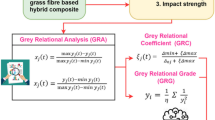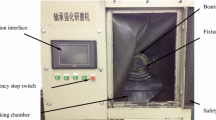Abstract
Lack of natural textile resources, the present textile industry in Taiwan usually uses pre-oriented yarn (POY), kind of artificial fibers, to make yarns. The POY is wound from continuous spinning of esterification and superposition of plastic pure terephthalic acid (PTA) and ethylene glycol (EG). According to yarn assessment indicators, yarn breakage of POY is crucial. And the broken filament and toughness are the most two important indicators causing yarn breakage during quality measurement. This study applies Taguchi Method to jointly consolidate broken filament degradation rate and toughness elongation percentage to establish a proper orthogonal array. The experimental control factors includes knotting device type, winding tension (CN), oil rate (%), and knotting pressure (kg/cm2), and a L 18(21×37) orthogonal array is established. The key parameter design of control factors can be found by Taguchi experiment. The fuzzy inference is combined with Taguchi multiple quality characteristics to construct the process parameter module to effectively increase product yield.
Similar content being viewed by others
References
G. Taguchi, E. A. Elsayed, and T. C. Hsiang, “Quality Engineering in Production Systems”, pp.1–10, McGraw-Hill Book Co., New York, 1989.
L. A. Zadeh, Inform. and Control, 8, 338 (1965).
Y. S. Tarng, W. H. Yang, and S. C. Juang, Int. J. Adv. Manuf. Technol., 16, 688 (2000).
J. S. Kim, H. J. An, K. Y. Kim, W. Y. Jeong, N. H. Park, D. Y. Lim, and D. H. Kim, Fiber. Polym., 14, 2128 (2013).
L. I. Tong and C. T. Su, Qual. Reliab. Eng. Int., 13, 25 (1997).
A. K. Pandey and A. K. Dubey, Opt. Lasers Eng., 50, 328 (2012).
Y. S. Yang and W. Huang, Expert Syst. Appl., 39, 743 (2012).
S. Das, A. Ghosh, A. Majumdar, and D. Banerjee, Fiber. Polym., 14, 1220 (2013).
M. S. Phadke, “Quality Engineering Using Robust Design”, Prentice-Hall, 1989.
P. J. Rose, “Taguchi Techniques for Quality Engineering”, McGraw-Hill Book Co., New York, 1996.
T. N. Tsai, Comput.-Integr. Manuf., 27, 808 (2011).
O. Saligheh, R. Eslami-Farsani, R. Khajavi, and M. Forouharshad, Polymers, 14, 1864 (2013).
Author information
Authors and Affiliations
Corresponding author
Rights and permissions
About this article
Cite this article
Huang, ML., Hung, YH. & Kuo, WC. Combining Taguchi Method with fuzzy inference on process optimization for fiber manufacturing. Fibers Polym 16, 2670–2681 (2015). https://doi.org/10.1007/s12221-015-5627-9
Received:
Revised:
Accepted:
Published:
Issue Date:
DOI: https://doi.org/10.1007/s12221-015-5627-9




